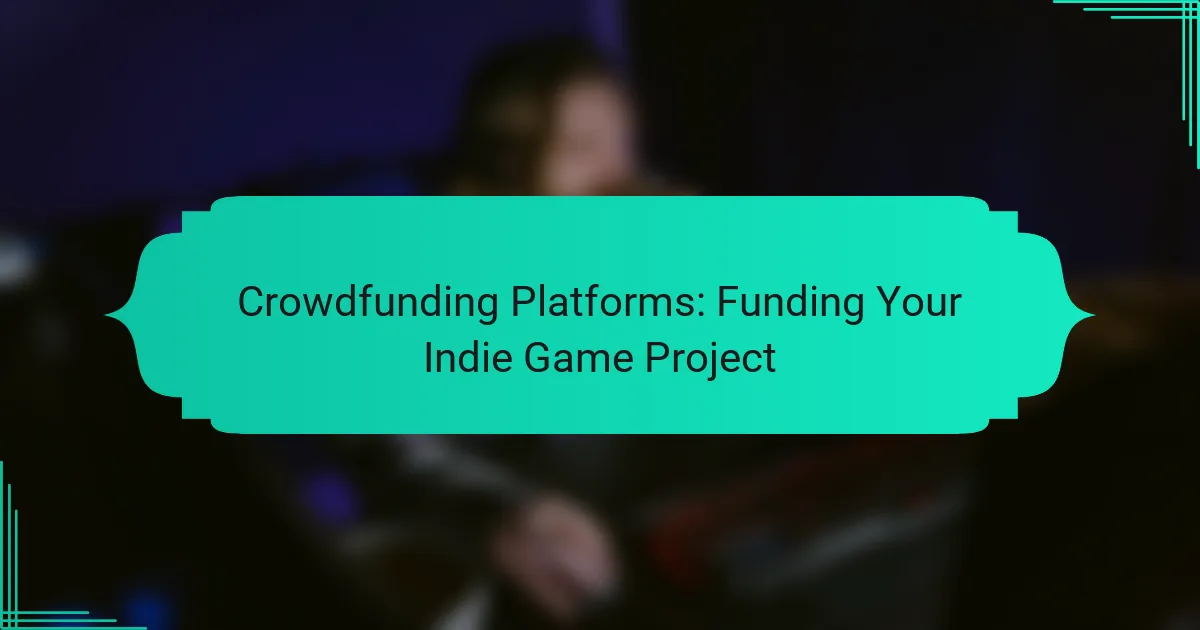Crowdfunding platforms are essential for indie game developers seeking financial support for their projects. Key features include flexible funding options, community engagement tools, and effective reward systems. Understanding audience engagement and cultural influences can significantly enhance funding success. Tracking vital metrics helps creators optimize their campaigns and achieve their financial goals.
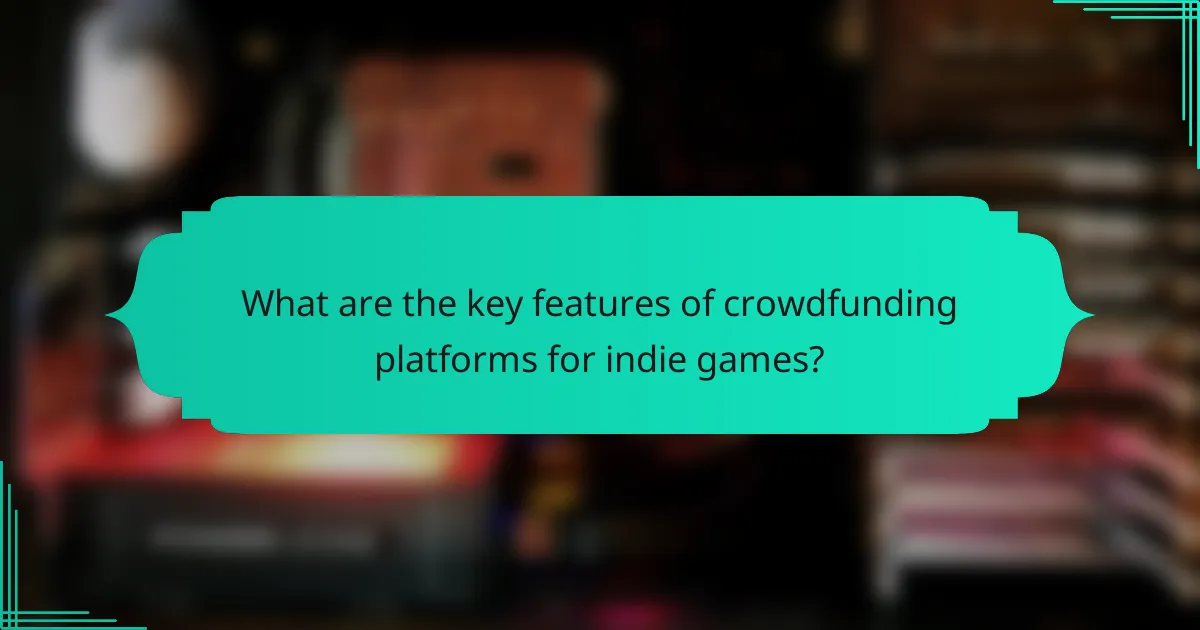
What are the key features of crowdfunding platforms for indie games?
Crowdfunding platforms for indie games offer essential features to support project funding. Key features include flexible funding options, community engagement tools, reward systems, project visibility, and analytics for tracking progress.
Flexible funding allows creators to choose between all-or-nothing or keep-it-all models, impacting how they approach their goals. Community engagement tools foster interaction between developers and backers, creating a loyal fan base. Reward systems incentivize contributions with tiered benefits, enhancing backer motivation.
Project visibility is crucial as it helps indie games stand out in a crowded market, often aided by platform promotion. Analytics provide insights into funding trends and backer demographics, enabling creators to refine their strategies.
How do different platforms cater to indie game developers?
Crowdfunding platforms provide essential funding opportunities for indie game developers by connecting them directly with potential backers. These platforms, such as Kickstarter and Indiegogo, allow developers to showcase their projects and secure financial support from a community of gamers and enthusiasts.
Kickstarter is known for its all-or-nothing funding model, which encourages developers to set realistic funding goals. Indiegogo, on the other hand, offers flexible funding options, allowing developers to keep funds even if the goal isn’t met. This adaptability caters to various project needs and risk levels.
Additionally, platforms often provide promotional tools and community engagement features. For example, successful campaigns can gain visibility through platform highlights, attracting more backers. This exposure is vital for indie developers seeking to establish a presence in a competitive market.
In summary, crowdfunding platforms uniquely support indie game developers by providing funding mechanisms, promotional tools, and community engagement opportunities tailored to their specific needs and project goals.
What payment structures do crowdfunding platforms typically use?
Crowdfunding platforms typically use three main payment structures: all-or-nothing, keep-it-all, and flexible funding. All-or-nothing requires projects to meet their funding goal to receive any money. Keep-it-all allows creators to keep whatever funds are raised, regardless of the goal. Flexible funding combines elements of both, offering creators some financial support even if the goal isn’t met. These structures influence project viability and creator strategy.
Which platforms are most popular among indie game creators?
Indie game creators favor platforms like Kickstarter, Indiegogo, and Patreon for crowdfunding. These platforms offer diverse funding mechanisms and community engagement features. Kickstarter is known for its all-or-nothing funding model, while Indiegogo provides flexible funding options. Patreon allows ongoing support through subscriptions, catering to creators seeking long-term funding. Each platform has unique attributes that can enhance visibility and funding potential for indie projects.
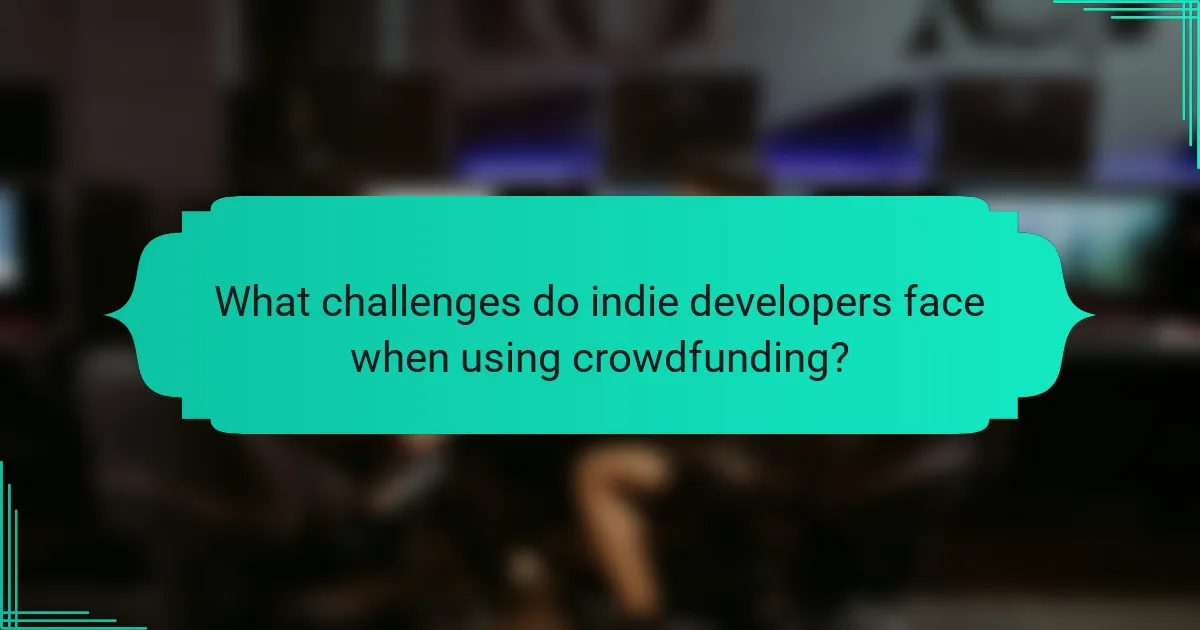
What challenges do indie developers face when using crowdfunding?
Indie developers face several challenges when using crowdfunding, including visibility, funding goals, and community engagement. Limited marketing resources can hinder project exposure, making it difficult to attract backers. Setting realistic funding goals is crucial; overly ambitious targets may lead to project failure. Additionally, maintaining active communication with supporters is essential for building trust and sustaining momentum throughout the campaign.
How can developers effectively communicate their project vision?
Developers can effectively communicate their project vision by clearly defining goals, engaging storytelling, and utilizing visual aids. Establishing a strong narrative captures interest and conveys passion. Visual elements like concept art and prototypes enhance understanding and appeal. Regular updates foster community involvement and feedback, ensuring alignment with backer expectations.
What common pitfalls should indie developers avoid during campaigns?
Indie developers should avoid common pitfalls like inadequate planning, unrealistic funding goals, and poor marketing strategies during crowdfunding campaigns. These mistakes can lead to project failure and loss of backer trust.
1. Lack of a detailed budget can result in funding shortfalls.
2. Setting an unachievable funding target may deter potential backers.
3. Failing to create a strong marketing plan can limit visibility.
4. Ignoring community engagement can lead to a disconnect with backers.
5. Underestimating project timelines can cause delays and frustration.
6. Neglecting to update backers regularly can diminish their support.
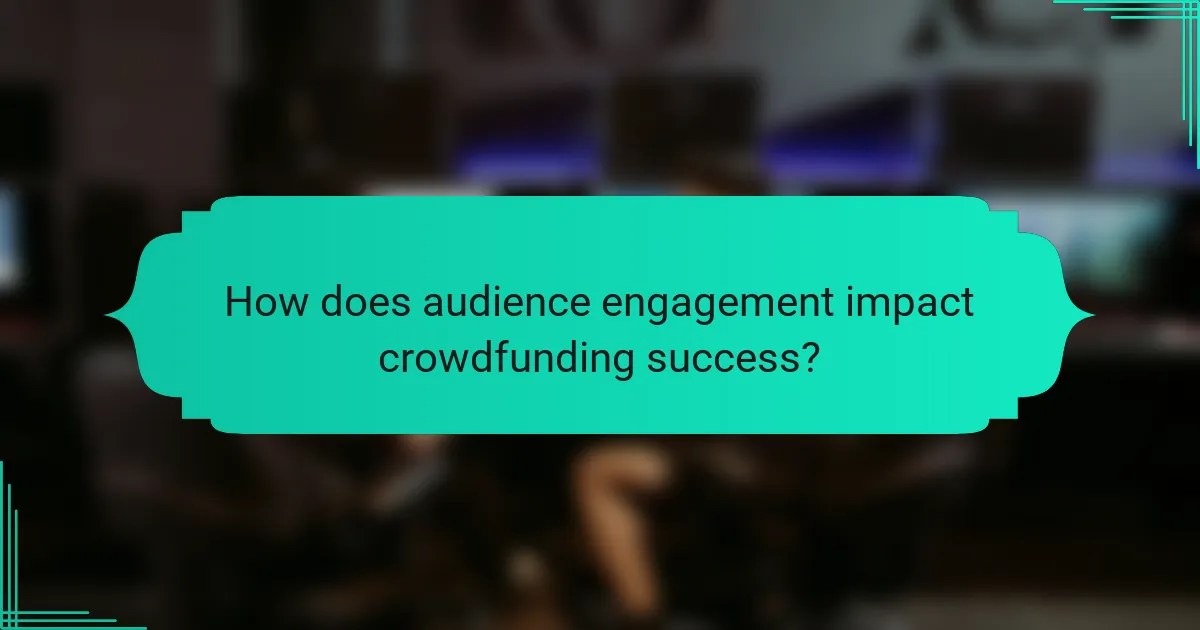
How does audience engagement impact crowdfunding success?
Audience engagement significantly boosts crowdfunding success by fostering community support and trust. Engaged audiences are more likely to contribute financially, share the campaign, and promote it within their networks. This organic reach increases visibility and attracts potential backers. High engagement levels can lead to a sense of ownership among supporters, encouraging larger contributions. Additionally, campaigns with active engagement often achieve funding goals more swiftly, creating momentum that attracts further interest.
Which strategies can boost backer interaction and support?
Engaging backers effectively boosts support for indie game projects on crowdfunding platforms. Utilize social media to share updates and foster community interaction. Offer exclusive rewards to incentivize contributions and maintain interest. Regularly communicate progress through newsletters or live streams to create transparency and trust. Leverage backer feedback to enhance project development, making supporters feel valued and involved.
What role does social media play in promoting crowdfunding campaigns?
Social media significantly boosts crowdfunding campaigns by increasing visibility and engagement. It allows creators to share their projects with wider audiences, fostering community support. Platforms like Facebook and Twitter enable real-time updates, encouraging backers to participate and share. As a result, effective social media strategies can lead to higher funding amounts and successful project launches.
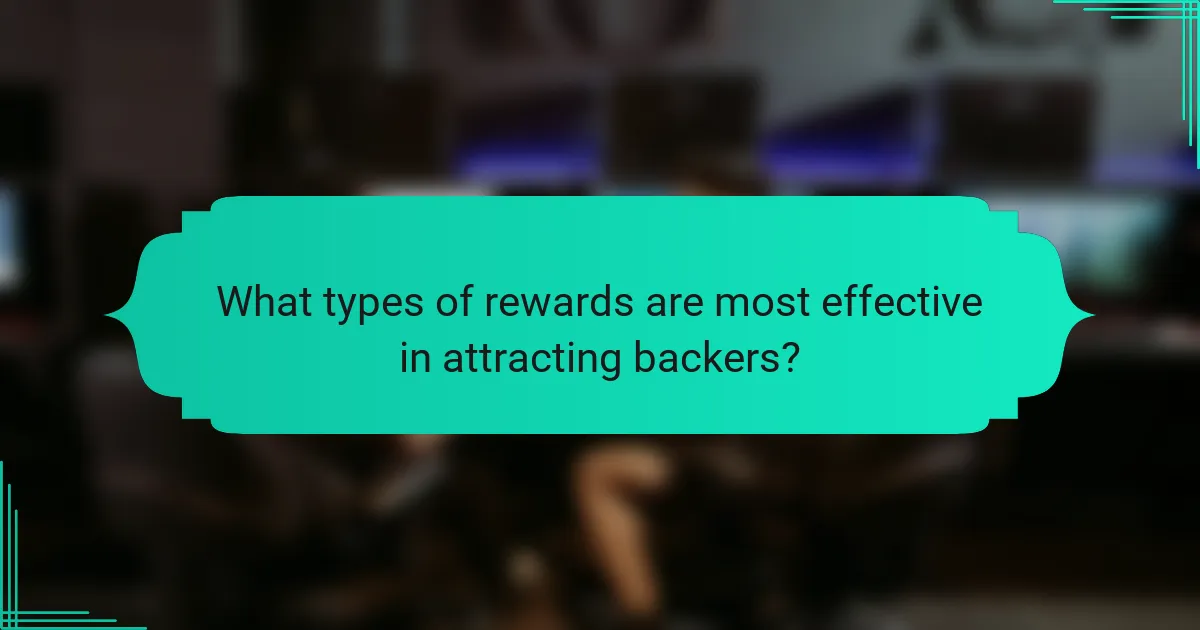
What types of rewards are most effective in attracting backers?
Effective rewards for attracting backers include exclusive content, early access, and tangible merchandise. These incentives create a sense of value and connection. Exclusive digital items, such as in-game assets or behind-the-scenes access, enhance engagement. Early access allows backers to experience the game before its official release, fostering loyalty. Tangible rewards, like branded merchandise, provide physical reminders of support, appealing to collectors.
How do tiered reward systems influence funding outcomes?
Tiered reward systems significantly enhance funding outcomes by incentivizing backers at multiple contribution levels. These systems create a sense of progression, encouraging higher pledges. For instance, a game project may offer exclusive in-game items or early access for higher tiers, which can attract more funding. Additionally, they foster community engagement as backers feel valued and part of the project’s success. Ultimately, tiered rewards can lead to increased visibility and momentum, driving further contributions through social sharing and word-of-mouth.
Which unique rewards have proven successful in past campaigns?
Unique rewards that have proven successful in past crowdfunding campaigns for indie games include exclusive in-game items, personalized experiences, and behind-the-scenes access. These unique attributes create a sense of value and connection for backers, enhancing their engagement. For example, limited edition artwork or character skins can attract more funding. Additionally, offering the chance to participate in game development decisions has shown to resonate well with supporters.
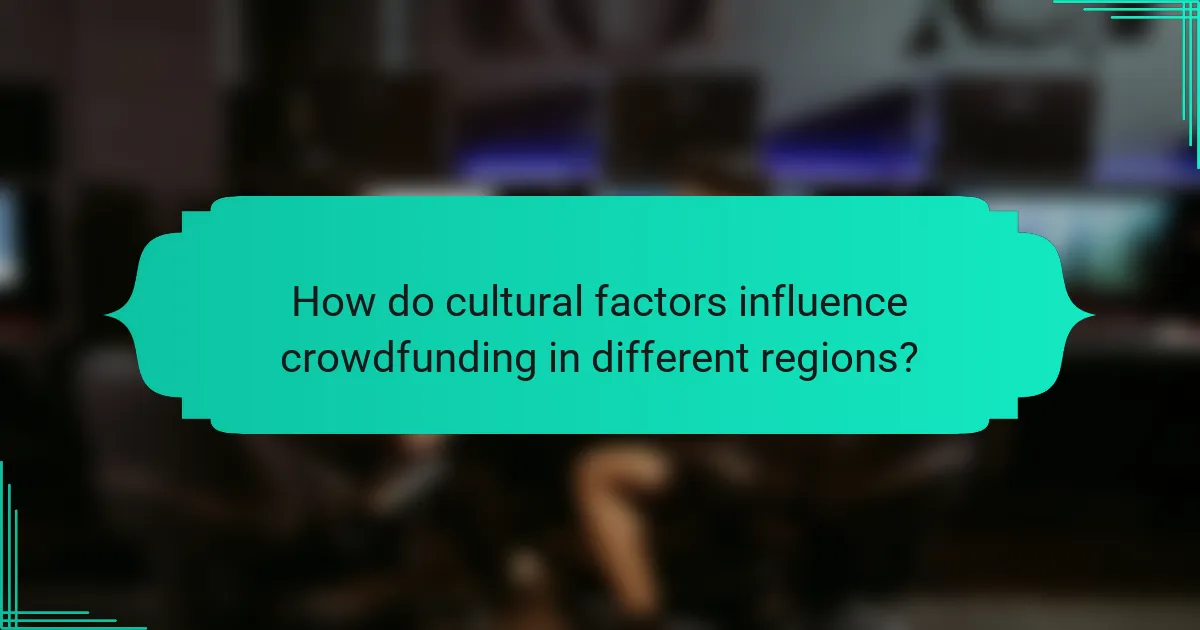
How do cultural factors influence crowdfunding in different regions?
Cultural factors significantly influence crowdfunding by shaping preferences and behaviors in different regions. For instance, individualistic cultures may prioritize personal projects, while collectivist societies might support community-oriented initiatives. Regional economic conditions also affect funding levels, as wealthier areas tend to see higher contributions. Additionally, cultural attitudes toward risk and innovation impact the willingness to invest in new ideas. Understanding these dynamics can enhance the effectiveness of crowdfunding campaigns tailored to specific regional audiences.
What regional trends affect funding strategies for indie games?
Regional trends significantly influence funding strategies for indie games by shaping preferences and expectations. For example, North America shows a high demand for innovative gameplay, while European markets often favor unique art styles. Asian regions may emphasize mobile gaming, affecting platform choice. Understanding these trends allows developers to tailor their crowdfunding campaigns effectively. Moreover, cultural factors impact the types of rewards that resonate with backers, enhancing engagement. Adapting to local preferences can lead to increased funding success.
How do funding goals vary across different markets?
Funding goals for indie game projects vary significantly across different crowdfunding platforms. Each market has distinct characteristics that influence the amount of financial support sought. For instance, platforms like Kickstarter often see higher funding goals due to their larger audience and established reputation, while newer platforms may have lower expectations.
Additionally, geographic location impacts funding goals. Projects in regions with a strong gaming culture typically set higher targets compared to those in emerging markets. The type of game also plays a role; innovative or unique concepts may attract more funding than conventional ideas.
Furthermore, the funding model affects goals. All-or-nothing campaigns usually require higher targets, while flexible funding options may allow for lower goals. Understanding these variations helps creators tailor their strategies for successful funding outcomes.
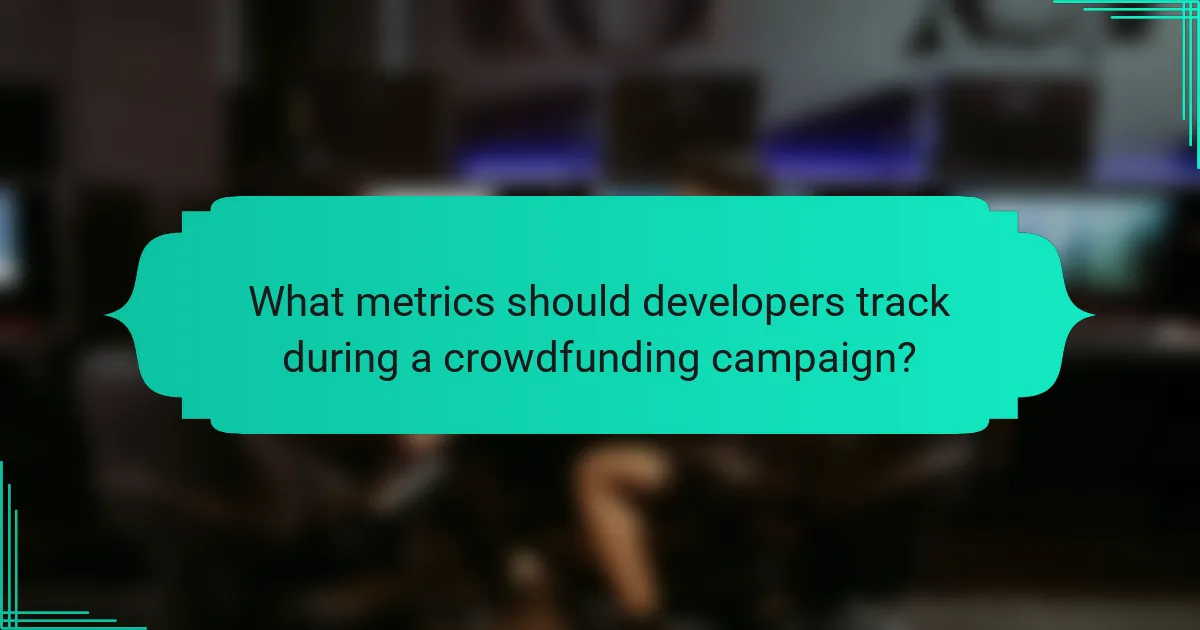
What metrics should developers track during a crowdfunding campaign?
Developers should track metrics such as funding progress, backer engagement, social media reach, and campaign conversion rates during a crowdfunding campaign. These metrics provide insights into campaign performance and help optimize strategies.
| Metric | Description |
|————————-|————————————————–|
| Funding Progress | Amount raised vs. funding goal |
| Backer Engagement | Number of backers and comments |
| Social Media Reach | Followers and shares across platforms |
| Campaign Conversion Rate | Percentage of visitors who become backers |
| Updates Frequency | Regularity of project updates to backers |
| Referral Sources | Channels driving traffic to the campaign page |
How can analytics improve campaign performance?
Analytics can significantly enhance campaign performance by providing data-driven insights. These insights help identify target audiences, optimize marketing strategies, and improve engagement rates.
By analyzing user behavior and preferences, crowdfunding platforms can tailor campaigns to meet specific interests. This targeted approach can increase funding success rates. For instance, platforms that utilize analytics effectively see an average funding increase of 30%.
Additionally, real-time analytics allow creators to adjust their strategies dynamically. This flexibility ensures campaigns resonate with backers, maximizing contributions. Campaigns that respond to analytics can experience up to 50% higher engagement.
Incorporating analytics into crowdfunding strategies not only boosts performance but also fosters community involvement. Engaging backers through personalized updates based on analytics can strengthen relationships and encourage further support.
What are the key performance indicators for measuring success?
Key performance indicators for crowdfunding platforms include total funds raised, number of backers, average pledge amount, project completion rate, and social media engagement. These metrics help assess the effectiveness and reach of your indie game project. Tracking these indicators allows creators to refine their strategies and improve future campaigns.

What best practices can maximize crowdfunding success for indie games?
To maximize crowdfunding success for indie games, creators should focus on building a strong community, presenting a compelling story, and offering attractive rewards. Engaging potential backers through social media and regular updates fosters trust and enthusiasm. A well-crafted video showcasing gameplay and developer passion can significantly enhance appeal. Clear funding goals and transparent budgeting also reassure backers, increasing the likelihood of reaching financial targets.
How can storytelling enhance a crowdfunding pitch?
Storytelling can significantly enhance a crowdfunding pitch by creating an emotional connection with potential backers. A compelling narrative captures attention, making the project memorable and relatable. Engaging stories can illustrate the project’s vision, challenges, and impact, which can motivate support.
Effective storytelling often includes personal anecdotes, character development, and vivid imagery. This approach not only informs but also inspires, increasing the likelihood of funding. Additionally, storytelling can differentiate a project in a crowded marketplace, showcasing its unique attributes and value.
As a result, projects that incorporate storytelling typically experience higher engagement rates and funding success. Crowdfunding platforms favor pitches that resonate emotionally, leading to a stronger community around the project.
What expert tips can help indie developers optimize their campaigns?
Indie developers can optimize their crowdfunding campaigns by focusing on clear goals, engaging storytelling, and strategic marketing. Tailor your pitch to resonate with your target audience and showcase unique aspects of your game. Utilize social media effectively to create buzz and build a community around your project. Regular updates during the campaign keep backers informed and engaged, fostering trust and excitement.
What are the most common mistakes to avoid in crowdfunding?
The most common mistakes to avoid in crowdfunding include setting unrealistic funding goals, neglecting marketing efforts, failing to engage with backers, and not providing clear project updates. These missteps can hinder the success of your indie game project.
1. Setting unrealistic funding goals can lead to project failure.
2. Neglecting marketing efforts reduces visibility and interest.
3. Failing to engage with backers diminishes trust and support.
4. Not providing clear project updates can alienate potential supporters.
